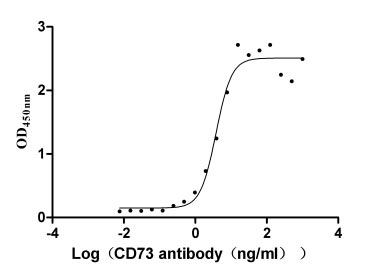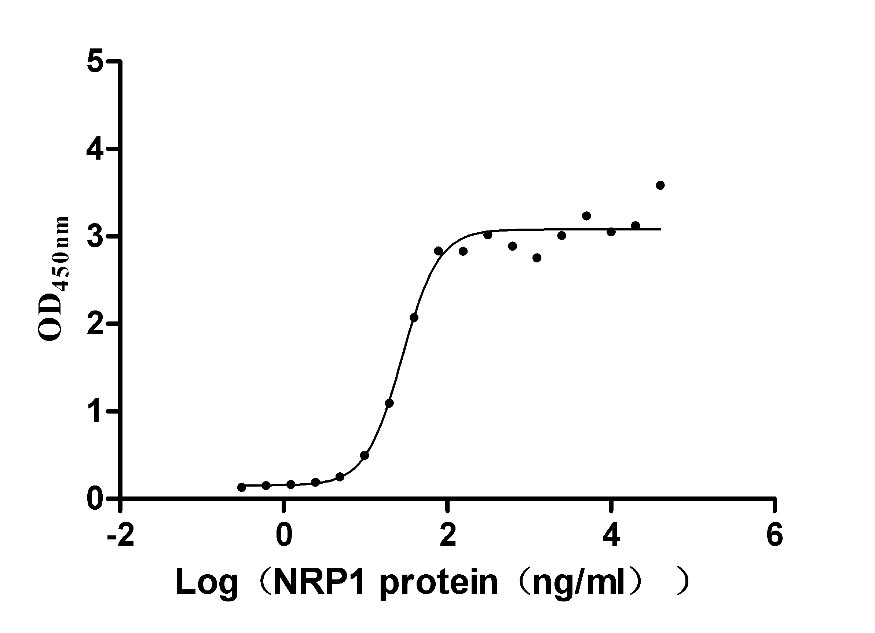Recombinant Human Homeobox protein Hox-D13 (HOXD13)
-
中文名称:人HOXD13重组蛋白
-
货号:CSB-YP010685HU
-
规格:
-
来源:Yeast
-
其他:
-
中文名称:人HOXD13重组蛋白
-
货号:CSB-EP010685HU
-
规格:
-
来源:E.coli
-
其他:
-
中文名称:人HOXD13重组蛋白
-
货号:CSB-EP010685HU-B
-
规格:
-
来源:E.coli
-
共轭:Avi-tag Biotinylated
E. coli biotin ligase (BirA) is highly specific in covalently attaching biotin to the 15 amino acid AviTag peptide. This recombinant protein was biotinylated in vivo by AviTag-BirA technology, which method is BriA catalyzes amide linkage between the biotin and the specific lysine of the AviTag.
-
其他:
-
中文名称:人HOXD13重组蛋白
-
货号:CSB-BP010685HU
-
规格:
-
来源:Baculovirus
-
其他:
-
中文名称:人HOXD13重组蛋白
-
货号:CSB-MP010685HU
-
规格:
-
来源:Mammalian cell
-
其他:
产品详情
-
纯度:>85% (SDS-PAGE)
-
基因名:HOXD13
-
Uniprot No.:
-
别名:HOXD13; HOX4I; Homeobox protein Hox-D13; Homeobox protein Hox-4I
-
种属:Homo sapiens (Human)
-
蛋白长度:Full length protein
-
表达区域:1-343
-
氨基酸序列MSRAGSWDMD GLRADGGGAG GAPASSSSSS VAAAAASGQC RGFLSAPVFA GTHSGRAAAA AAAAAAAAAA ASGFAYPGTS ERTGSSSSSS SSAVVAARPE APPAKECPAP TPAAAAAAPP SAPALGYGYH FGNGYYSCRM SHGVGLQQNA LKSSPHASLG GFPVEKYMDV SGLASSSVPA NEVPARAKEV SFYQGYTSPY QHVPGYIDMV STFGSGEPRH EAYISMEGYQ SWTLANGWNS QVYCTKDQPQ GSHFWKSSFP GDVALNQPDM CVYRRGRKKR VPYTKLQLKE LENEYAINKF INKDKRRRIS AATNLSERQV TIWFQNRRVK DKKIVSKLKD TVS
-
蛋白标签:Tag type will be determined during the manufacturing process.
The tag type will be determined during production process. If you have specified tag type, please tell us and we will develop the specified tag preferentially. -
产品提供形式:Lyophilized powder
Note: We will preferentially ship the format that we have in stock, however, if you have any special requirement for the format, please remark your requirement when placing the order, we will prepare according to your demand. -
复溶:We recommend that this vial be briefly centrifuged prior to opening to bring the contents to the bottom. Please reconstitute protein in deionized sterile water to a concentration of 0.1-1.0 mg/mL.We recommend to add 5-50% of glycerol (final concentration) and aliquot for long-term storage at -20℃/-80℃. Our default final concentration of glycerol is 50%. Customers could use it as reference.
-
储存条件:Store at -20°C/-80°C upon receipt, aliquoting is necessary for mutiple use. Avoid repeated freeze-thaw cycles.
-
保质期:The shelf life is related to many factors, storage state, buffer ingredients, storage temperature and the stability of the protein itself.
Generally, the shelf life of liquid form is 6 months at -20°C/-80°C. The shelf life of lyophilized form is 12 months at -20°C/-80°C. -
货期:Delivery time may differ from different purchasing way or location, please kindly consult your local distributors for specific delivery time.Note: All of our proteins are default shipped with normal blue ice packs, if you request to ship with dry ice, please communicate with us in advance and extra fees will be charged.
-
注意事项:Repeated freezing and thawing is not recommended. Store working aliquots at 4°C for up to one week.
-
Datasheet :Please contact us to get it.
相关产品
靶点详情
-
功能:Sequence-specific transcription factor that binds gene promoters and activates their transcription. Part of a developmental regulatory system that provides cells with specific positional identities on the anterior-posterior axis.
-
基因功能参考文献:
- The results suggest that the c.917G>A (p.R306Q) mutation in the HOXD13 gene, may be responsible for syndactyly type Ic in this family. PMID: 28498426
- a novel mutation causing truncation of HOXD13 protein was successfully identified as being associated with an atypical non-syndromic SPD phenotype in our study. PMID: 27254532
- down-regulation of HOXD13 might be a potentially useful prognostic marker for patients with breast cancer. PMID: 26617867
- A homozygous HOXD13 missense mutation causes a severe form of synpolydactyly with metacarpal to carpal transformation. PMID: 26581570
- HOXD13 methylation is a common event in primary breast cancer and is associated with poor survival of breast cancer patients. PMID: 26617782
- A 27 bp expansion mutation in exon 1 of HOXD13 was associated with autosomal dominant synpolydactyly in a Chinese family. PMID: 26252089
- Linkage analysis of the syndactyly type 1 subtype c (SD1-c) phenotype based on two Chinese families with 3/4 fingers syndactyly shows that two missense mutations in codon 306 of HOXD13 underlie SD1-c. PMID: 24789103
- Identification of a novel c.659G>C (p.Gly220Ala) mutation outside the HOXD13 homeodomain responsible for synpolydactyly in a Chinese family. PMID: 23948678
- Data indicate increased levels of reactive oxygen species (ROS) were detected in bone marrow nucleated cells (BMNC) that express CD71 in in NUP98-HOXD13 (NHD13) transgenic mice, a murine model for myelodysplastic syndromes (MDS). PMID: 23958061
- Molecular characteristics of a HOXD13 synpolydactyly 1 nonsense mutation in a Chinese family. PMID: 24055421
- findings show that expression of NUP98-HOXD13 impairs class switch recombination and reduces the antibody-mediated immune response, in addition to its role in leukemia PMID: 22613470
- Misexpression of HOXD13(G11A) in the developing chick limb phenocopied the human SPD phenotype PMID: 22373878
- This finding expands the phenotypic spectrum associated with HOXD13 mutations and advances our understanding of human limb development. PMID: 22374128
- Correlation between Synpolydactyly and alanine expansion in HOXD13. PMID: 22406499
- HOXD13 gene mutation was responsible for the synpolydactyly (SPD) phenotype in this family. PMID: 22161087
- results show the first nonsense mutation in the HOXD13 gene underlying a severe form of SPD in the homozygous state, and a milder form of SPD with approximately 50% penetrance in the heterozygous state. PMID: 21814222
- a duplication mutation, c. 186-212dup, in exon 1 of the HOXD13 gene in the affected individuals in a Chinese family with unusual clinical manifestations of synpolydactyly PMID: 20974300
- Variable skeletal phenotype in 2q31 deletion patients is a result of hemizygosity for the HOXD genes. PMID: 21068127
- results expand the spectrum of HOXD13 mutations;suggest that not only the size of the polyalanine repeat but also other unknown factors might play a role in synpolydactyly PMID: 19686284
- Data show that a mutant HOXD13 protein that recognizes only a subset of sites recognized by the wild-type protein causes a novel human limb malformation. PMID: 12620993
- Missense mutations in this protein are associated with brachydactyly types D and E. PMID: 12649808
- This is the first report on prenatal diagnosis of Synpolydactyly by detecting the HOXD13 polyalanine expansion in the Han population of the Chinese mainland. PMID: 15696469
- Results suggest that synpolydactyly in this kindred may be caused by polyalanine expansion in HOXD13. PMID: 15952114
- Data show that HOXD13 are important susceptible genes of idiopathic congenital talipes equinovarus. PMID: 16331564
- There is a link between HOXD13 and two additional limb phenotypes--syndactyly type V and brachydactyly type A4--and demonstrated that a polyalanine contraction in HOXD13, most likely, led to other digital anomalies but not to synpolydactyly. PMID: 17236141
- findings strongly suggest that specific mutations in HOXD13 gene may cause both hypoplastic synpolydactyly and hypospadias PMID: 17656229
- Early human development shows spatiotemporal differences of HOXD13 expression in the endodermal and mesodermal structures. PMID: 17853405
- We showed that SPD1 phenotype segregates with an identical expansion mutation of 21 bp in HOXD13. We show that HOXD13 polyalanine repeat is polymorphic, and the expansion of 2 alanine residues, is without clinical consequences. PMID: 18072967
- The results shows that HOXD13 gene mutation was not involved in outbreak in idiopathic congenital talipes equinovarus, but changes of HOXD13 and FHL1 gene expression related to the development of talipes equinovarus malformation. PMID: 18244901
- analysis of HOXD13 in 100 patients with limb malformations; 7 novel mutations in the coding region & 2 novel mutations in the 5'-untranslated region were identified PMID: 18399101
- transgenic mice expressing NUP98-HOXD13 (NHD13) fusion gene develop myelodysplastic syndrome, and more than half eventually progress to acute leukemia PMID: 18566322
- Hoxd13 and Fhl1 were expressed in the interdigital tissues of E12.5 rat embryo. Luciferase assay and EMSA identified a novel promoter region of Fhl1 that directly interacts with Hoxd13 PMID: 18758158
- G220V missense mutation of HOXD13 caused synpolydactyly in a Greek family. PMID: 19060004
- Detection of the HOXD13 homeoprotein in pancreas-tissue microarrays shows that its negative expression has a significant and adverse effect on the prognosis of patients with pancreatic cancer. PMID: 19488988
- Geminin, which interacts with HOXD13 as well, blocks HOXD13-mediated assembly of pre-replication complex proteins and inhibits HOXD13-induced DNA replication. PMID: 19703996
- Gene Structure and Report of Nine Polyalanine Duplications in Families with Synpolydactyly, Type II PMID: 8817328
显示更多
收起更多
-
相关疾病:Synpolydactyly 1 (SPD1); Brachydactyly D (BDD); Syndactyly 5 (SDTY5); Brachydactyly-syndactyly syndrome (BDSD); Brachydactyly E1 (BDE1); VACTERL association (VACTERL); Brachydactyly-syndactyly-oligodactyly syndrome (BDSDO)
-
亚细胞定位:Nucleus.
-
蛋白家族:Abd-B homeobox family
-
数据库链接:
HGNC: 5136
OMIM: 113200
KEGG: hsa:3239
STRING: 9606.ENSP00000376322
UniGene: Hs.152414
Most popular with customers
-
Recombinant Human 5'-nucleotidase (NT5E) (Active)
Express system: Mammalian cell
Species: Homo sapiens (Human)
-
Recombinant Human Semaphorin-4D (SEMA4D), partial (Active)
Express system: Mammalian cell
Species: Homo sapiens (Human)
-
Recombinant Human Neuropilin-1 (NRP1) (Active)
Express system: Mammalian cell
Species: Homo sapiens (Human)
-
Recombinant Human Glucagon receptor (GCGR), partial (Active)
Express system: Mammalian cell
Species: Homo sapiens (Human)
-
Recombinant Human Signal transducer CD24 (CD24)-Nanoparticle (Active)
Express system: Mammalian cell
Species: Homo sapiens (Human)
-
Recombinant Rabbit Tissue factor pathway inhibitor (TFPI) (Active)
Express system: Mammalian cell
Species: Oryctolagus cuniculus (Rabbit)
-
Recombinant Human Microtubule-associated protein tau (MAPT) (Active)
Express system: Mammalian cell
Species: Homo sapiens (Human)
-
Recombinant Human Claudin-3 (CLDN3)-VLPs (Active)
Express system: Mammalian cell
Species: Homo sapiens (Human)








-AC1.jpg)











